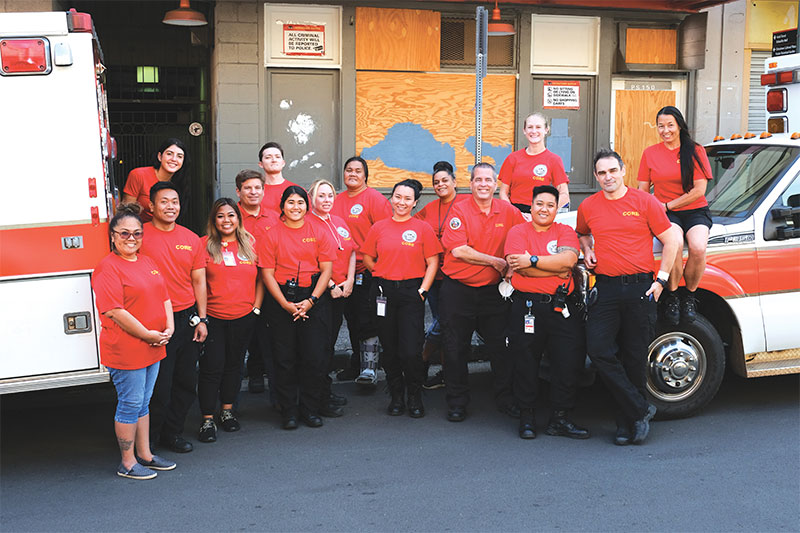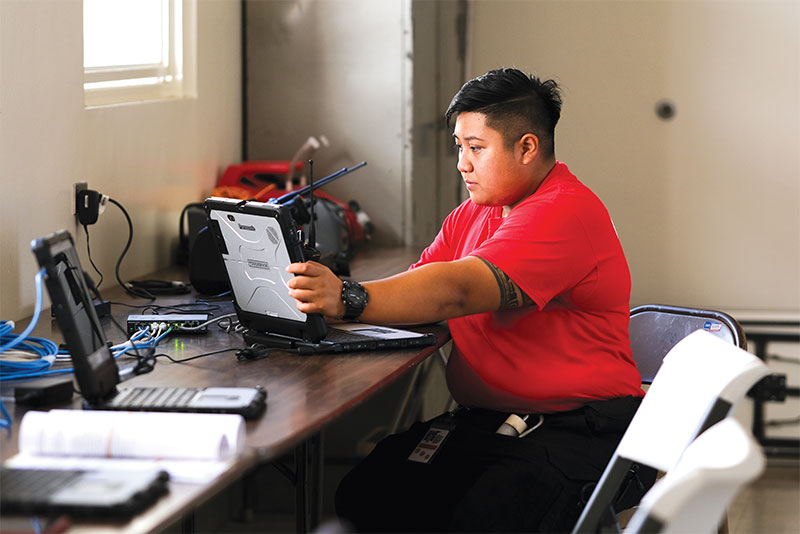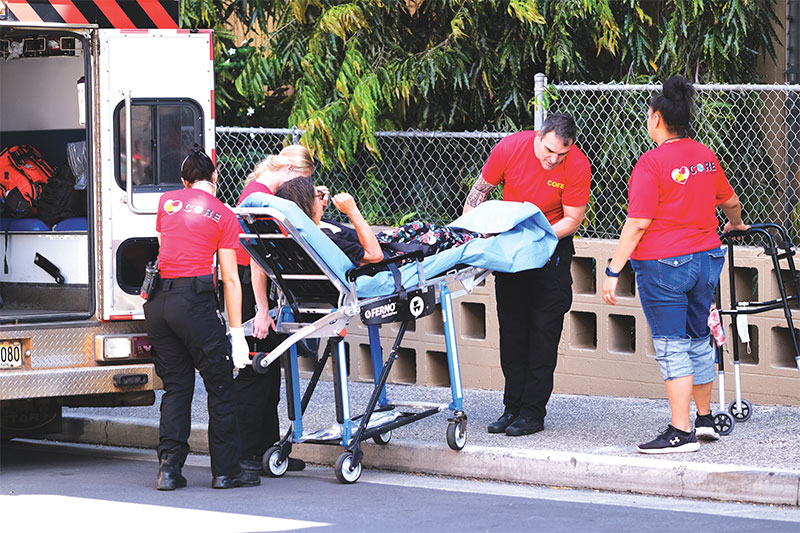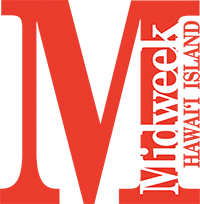Core Values

Members of the CORE team is available to serve O‘ahu communities seven days a week.
At the heart of Honolulu Emergency Services Department’s newest program is a hardworking team looking out for and taking care of the city’s houseless population, with director Dr. James Ireland leading the way.
Tonight, there are nearly 4,000 people on O‘ahu who don’t have a bed to sleep in. They don’t know when their next bite of food or sip of water will be, nor do they have access to medical care or transportation to get from A to B.
It’s no secret that homelessness is prevalent on Honolulu’s streets. But here to do something about it is a small but mighty team of 30 individuals, who — with dignity, respect and compassion — are putting in the groundwork to get O‘ahu’s homeless taken care of, one person at a time.

EMT Julianne Fajotina reviews charts in the CORE office in Chinatown.
Last year, a task force featuring officials from the Mayor’s Office of Housing and Homelessness, the nonprofit sector, Honolulu Police Department, Honolulu Emergency Services Department as well as homeless individuals, among others, met for six weeks. The group had one goal and one goal only:
Find ways in which the city can better serve the island’s houseless population.
What came out of those discussions was CORE (Crisis, Outreach, Response and Engagement), a mostly federally funded program within the city’s Emergency Services Department.

CORE EMTs and staff work with an injured person.
Composed of emergency medical technicians, community health personnel, social workers and supervisors, CORE takes to the streets seven days a week, and just like its acronym suggests, the team frequents heavily populated areas — like Chinatown, Downtown Honolulu and Waikīkī — to not only meet the immediate needs of houseless individuals, such as treating wounds and changing bandages, but also get to know them on a first-name basis and listen to what other ways it can help.
One of the many reasons why CORE was established was to provide relief for Honolulu’s EMS and police departments, which have become inundated in the last few years. Dr. James Ireland — the director of Honolulu Emergency Services Department who served in the U.S.Army Reserves as a combat medic and later for the city as an EMT — recalls his time in the back of an ambulance. Around 30 years ago, he says, people would generally only dial 911 for critical emergencies like a heart attack or stroke, but in the time since, there’s been a culture shift. Today, 911 dispatchers have never been busier.
“People still need care, but they don’t necessarily need a 911 ambulance with highly trained medics,” Ireland says. “The things I’m referring to are people calling about gout pain in their ankle, the sniffles or because they ran out of medication. What we’re noticing is that unfortunately a lot of the calls are coming from people in the homeless community, just because they don’t have access to a doctor, clinic, transportation, or money for a cab or Uber, so they disproportionately use 911 a lot.
“We only have a limited number of 911 ambulances and they’re responding to these minor calls that homeless individuals are calling for, which takes them away from being able to respond to the beach for a drowning or for a major car accident.”
The same goes for the police department. “There are a lot of reasons why people are homeless … but what I found in working in EMS and now CORE is that the majority do have issues with mental illness and substance abuse, as well as chronic medical conditions and dementia,” explains Ireland. “When a homeless person causes a disruption, lashes out or is laying on the sidewalk, historically, the police were called. The police would come to the scene, but they don’t necessarily have the same degree of medical training as the people in the ambulance. We’re asking the police to deal with medical problems using police training, and that doesn’t always work well.
“So, we really needed to find a better way to take care of the chronically homeless people, particularly with mental and substance abuse issues, that wasn’t pure police and pure EMS, so that’s where CORE has a role to play in addressing this.”
Ireland emphasizes that CORE, which dons red shirts and sometimes blue jeans as a way to deem themselves as more approachable, is in no way replacing EMS or police when it comes to extremities. Rather, they’re filling a gap for the nonviolent and nonfatal matters, becoming yet another tool in a collaborative effort to combat homelessness on O‘ahu.
Besides the medical component, CORE serves as a liaison of sorts, by connecting the individual with a plethora of resources including hygiene centers, health clinics, psychiatric services (soon, they’ll have one on staff) and, of course, shelters and permanent housing. CORE also assists with obtaining identification, a task that seems minuscule but can be life-changing and open dozens of doors for things like bus passes, health insurance and other means of paperwork-heavy support.
“There was a gentleman who was homeless for five years on River Street who was eligible for nursing home care through the Veterans Administration; he was a veteran,” says Ireland. “The team helped him, through the VA, apply so that he would get those services that he was entitled to. He’s off the streets now. Sometimes it’s just going that extra mile, working collaboratively and lining up the stars.”
While it appears that CORE drives ambulances similar to EMS’s (it’s stocked with everything from life-saving equipment to adult diapers), a notable disparity is that it can take its passengers to places other than an emergency room.
“EMS go to the 911 call and transports people to the ER. Once that hand-off is done, we wish the patient well, clean up the ambulance and go to the next call,” explains Ireland. “With CORE, we don’t want them to necessarily do that. We want to set that person up for success. That’s why we tell the CORE team, if you need to spend an hour or two with somebody — do it.
“Some of the people that CORE is dealing with call 911 every day,” he adds. “We have a handful of individuals who have called 911 over 100 times a year. So, spending that extra time with somebody like that will save a hundred 911 calls for the rest of the year because they get some type of definitive service.”
In these refurbished ambulances, CORE’s team has the ability to drive its staff and supplies all around the island, as well. It recently visited the Windward side, Wai‘anae and Diamond Head/Kaimukī, with upcoming plans to check out Pearl City/‘Aiea, Central O‘ahu and the North Shore, too.
“We know no part of O‘ahu is spared as far as people being homeless in the communities,” says Ireland. “We want to really help the whole island, but since we’re new, we’re taking it one step at a time.
“The populations of the people who are on the beach in Wai‘anae are different than the people you’ll find in the downtown or airport areas, so we need to tailor our response a little bit to the areas we go in so we can maximize our ability to help those we encounter.
“The biggest thing we want the public to know is that we’re just starting and nothing visual is going to happen overnight,” he adds. “But with the engagements CORE is making on the street, the people are beginning to trust our team members, and they’re taking our suggestions of getting them to a shelter, rehab or psychiatric care. We’ve gotten people into permanent housing.”
This summer, CORE’s team will expand to 50 personnel (it’s currently hiring) and one day may open an opportunity for volunteers to lend a hand. Soon, it will also launch a website and social media platform so the community can not only stay up to date about what it’s accomplishing but submit concerns they have about homeless people in their neighborhood. For now, residents can call 808-768-2673, which is CORE’s official hotline.
With military experience and medical school under his belt, Ireland confesses that CORE is without a doubt the hardest challenge he’s ever taken on.
“It’s a process but we’re counting our victories, one person at a time.”


